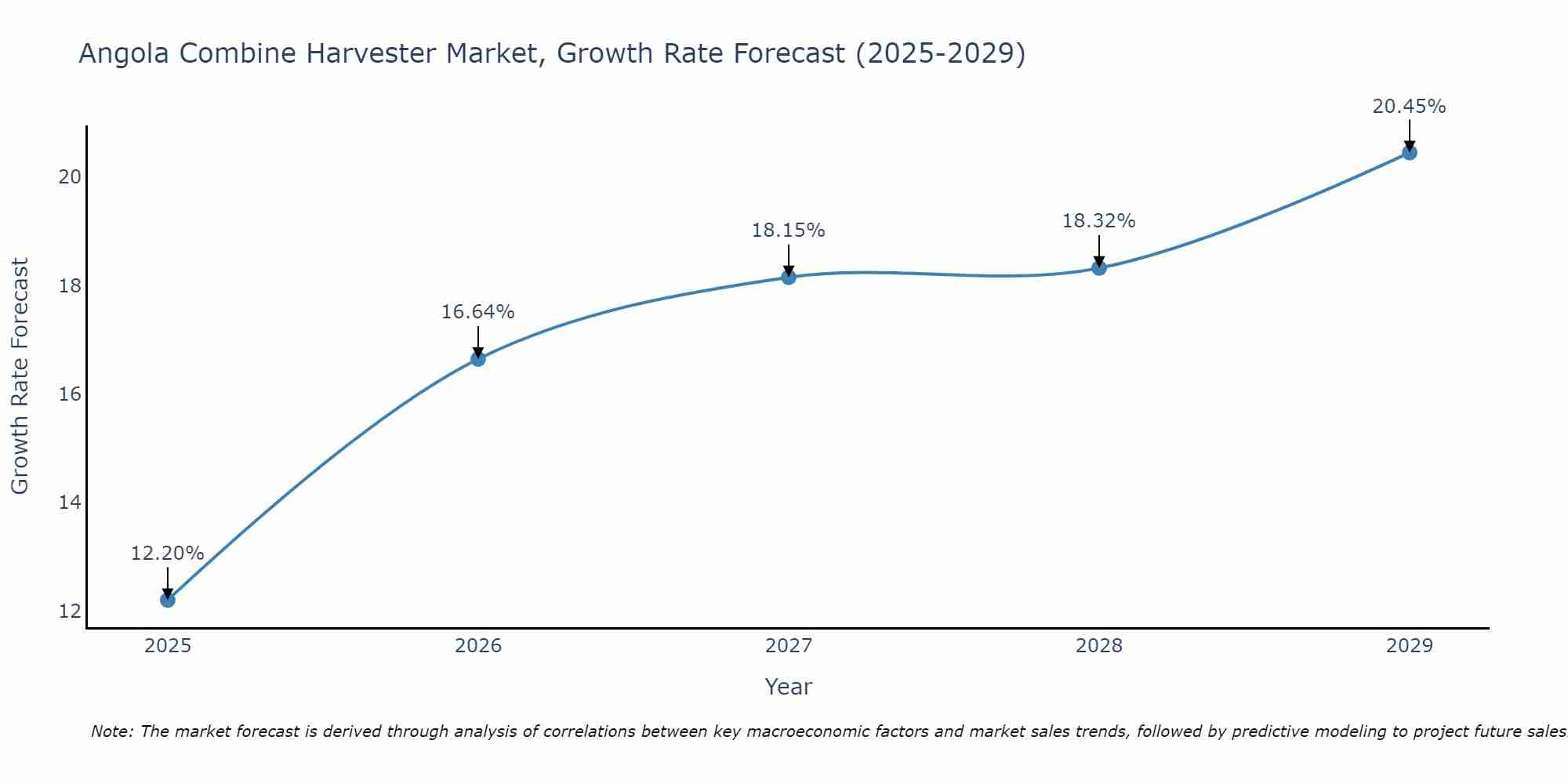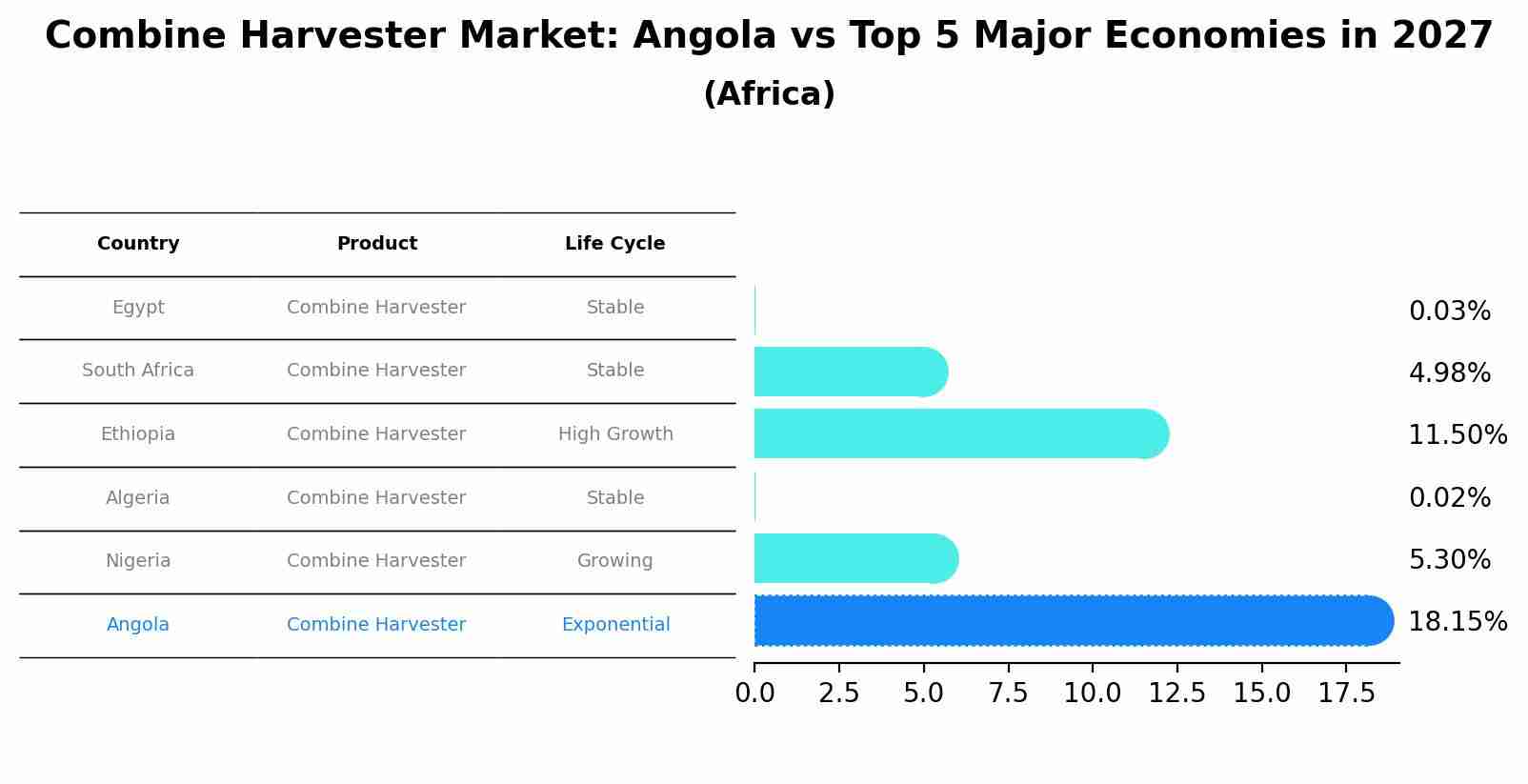Angola Combine Harvester Market (2025-2031) | Value, Share, Forecast, Companies, Industry, Revenue, Segmentation, Analysis, Trends, Outlook, Growth & Size
| Product Code: ETC5398200 | Publication Date: Nov 2023 | Updated Date: Aug 2025 | Product Type: Market Research Report | |
| Publisher: 6Wresearch | Author: Bhawna Singh | No. of Pages: 60 | No. of Figures: 30 | No. of Tables: 5 |
Angola Combine Harvester Market Size Growth Rate
The Angola Combine Harvester Market is likely to experience consistent growth rate gains over the period 2025 to 2029. From 12.20% in 2025, the growth rate steadily ascends to 20.45% in 2029.

Combine Harvester Market: Angola vs Top 5 Major Economies in 2027 (Africa)
In the Africa region, the Combine Harvester market in Angola is projected to expand at a exponential growth rate of 18.15% by 2027. The largest economy is Egypt, followed by South Africa, Ethiopia, Algeria and Nigeria.

Angola Combine Harvester Market Overview
In Angola, the Combine Harvester Market is evolving with agricultural mechanization efforts. The adoption of modern farming practices and government initiatives to boost food production are driving demand for efficient harvesting equipment.
Drivers of the market
The Angola combine harvester market is driven by the mechanization of agriculture, increasing agricultural productivity, and government initiatives promoting farm mechanization. Advancements in harvesting technology, such as GPS-guided systems and automated controls, are also contributing to market expansion.
Challenges of the market
The Angola combine harvester market confronts challenges such as agricultural mechanization barriers due to land tenure systems and small-scale farming practices. Infrastructure limitations, including inadequate rural roads and storage facilities, affect the efficiency and productivity of harvesting operations. Financial constraints and access to credit for smallholder farmers further hinder market growth and adoption of mechanized farming equipment.
Government Policy of the market
Government policies in Angola`s combine harvester market focus on agricultural modernization and food security. These policies often include subsidies for farm mechanization, import tariffs on agricultural machinery, and incentives for local manufacturing. Compliance with these policies enables companies to support Angola`s agricultural sector and contribute to increased crop productivity.
Key Highlights of the Report:
- Angola Combine Harvester Market Outlook
- Market Size of Angola Combine Harvester Market, 2024
- Forecast of Angola Combine Harvester Market, 2031
- Historical Data and Forecast of Angola Combine Harvester Revenues & Volume for the Period 2021-2031
- Angola Combine Harvester Market Trend Evolution
- Angola Combine Harvester Market Drivers and Challenges
- Angola Combine Harvester Price Trends
- Angola Combine Harvester Porter`s Five Forces
- Angola Combine Harvester Industry Life Cycle
- Historical Data and Forecast of Angola Combine Harvester Market Revenues & Volume By Cutting Width for the Period 2021-2031
- Historical Data and Forecast of Angola Combine Harvester Market Revenues & Volume By Small Size Combine Harvester for the Period 2021-2031
- Historical Data and Forecast of Angola Combine Harvester Market Revenues & Volume By Large Size Combine Harvester for the Period 2021-2031
- Historical Data and Forecast of Angola Combine Harvester Market Revenues & Volume By Type for the Period 2021-2031
- Historical Data and Forecast of Angola Combine Harvester Market Revenues & Volume By Wheel Type Combine Harvester for the Period 2021-2031
- Historical Data and Forecast of Angola Combine Harvester Market Revenues & Volume By Crawler Type Combine Harvester for the Period 2021-2031
- Historical Data and Forecast of Angola Combine Harvester Market Revenues & Volume By Power Source for the Period 2021-2031
- Historical Data and Forecast of Angola Combine Harvester Market Revenues & Volume By Tractor Pulled/PTO Powered Combine Harvester for the Period 2021-2031
- Historical Data and Forecast of Angola Combine Harvester Market Revenues & Volume By Self-Propelled Combine Harvester for the Period 2021-2031
- Angola Combine Harvester Import Export Trade Statistics
- Market Opportunity Assessment By Cutting Width
- Market Opportunity Assessment By Type
- Market Opportunity Assessment By Power Source
- Angola Combine Harvester Top Companies Market Share
- Angola Combine Harvester Competitive Benchmarking By Technical and Operational Parameters
- Angola Combine Harvester Company Profiles
- Angola Combine Harvester Key Strategic Recommendations
Frequently Asked Questions About the Market Study (FAQs):
1 Executive Summary |
2 Introduction |
2.1 Key Highlights of the Report |
2.2 Report Description |
2.3 Market Scope & Segmentation |
2.4 Research Methodology |
2.5 Assumptions |
3 Angola Combine Harvester Market Overview |
3.1 Angola Country Macro Economic Indicators |
3.2 Angola Combine Harvester Market Revenues & Volume, 2021 & 2031F |
3.3 Angola Combine Harvester Market - Industry Life Cycle |
3.4 Angola Combine Harvester Market - Porter's Five Forces |
3.5 Angola Combine Harvester Market Revenues & Volume Share, By Cutting Width, 2021 & 2031F |
3.6 Angola Combine Harvester Market Revenues & Volume Share, By Type, 2021 & 2031F |
3.7 Angola Combine Harvester Market Revenues & Volume Share, By Power Source, 2021 & 2031F |
4 Angola Combine Harvester Market Dynamics |
4.1 Impact Analysis |
4.2 Market Drivers |
4.2.1 Increasing demand for mechanization in agriculture to improve efficiency and productivity |
4.2.2 Government initiatives to support modernization of agricultural practices |
4.2.3 Growth in commercial farming activities leading to higher adoption of combine harvesters |
4.3 Market Restraints |
4.3.1 High initial investment and maintenance costs of combine harvesters |
4.3.2 Limited access to financing for small-scale farmers to purchase equipment |
4.3.3 Lack of skilled operators and maintenance services for combine harvesters |
5 Angola Combine Harvester Market Trends |
6 Angola Combine Harvester Market Segmentations |
6.1 Angola Combine Harvester Market, By Cutting Width |
6.1.1 Overview and Analysis |
6.1.2 Angola Combine Harvester Market Revenues & Volume, By Small Size Combine Harvester, 2021-2031F |
6.1.3 Angola Combine Harvester Market Revenues & Volume, By Large Size Combine Harvester, 2021-2031F |
6.2 Angola Combine Harvester Market, By Type |
6.2.1 Overview and Analysis |
6.2.2 Angola Combine Harvester Market Revenues & Volume, By Wheel Type Combine Harvester, 2021-2031F |
6.2.3 Angola Combine Harvester Market Revenues & Volume, By Crawler Type Combine Harvester, 2021-2031F |
6.3 Angola Combine Harvester Market, By Power Source |
6.3.1 Overview and Analysis |
6.3.2 Angola Combine Harvester Market Revenues & Volume, By Tractor Pulled/PTO Powered Combine Harvester, 2021-2031F |
6.3.3 Angola Combine Harvester Market Revenues & Volume, By Self-Propelled Combine Harvester, 2021-2031F |
7 Angola Combine Harvester Market Import-Export Trade Statistics |
7.1 Angola Combine Harvester Market Export to Major Countries |
7.2 Angola Combine Harvester Market Imports from Major Countries |
8 Angola Combine Harvester Market Key Performance Indicators |
8.1 Average utilization rate of combine harvesters in Angola |
8.2 Adoption rate of precision agriculture technologies in conjunction with combine harvesters |
8.3 Efficiency improvement rate in crop harvesting processes using combine harvesters |
9 Angola Combine Harvester Market - Opportunity Assessment |
9.1 Angola Combine Harvester Market Opportunity Assessment, By Cutting Width, 2021 & 2031F |
9.2 Angola Combine Harvester Market Opportunity Assessment, By Type, 2021 & 2031F |
9.3 Angola Combine Harvester Market Opportunity Assessment, By Power Source, 2021 & 2031F |
10 Angola Combine Harvester Market - Competitive Landscape |
10.1 Angola Combine Harvester Market Revenue Share, By Companies, 2024 |
10.2 Angola Combine Harvester Market Competitive Benchmarking, By Operating and Technical Parameters |
11 Company Profiles |
12 Recommendations | 13 Disclaimer |
- Single User License$ 1,995
- Department License$ 2,400
- Site License$ 3,120
- Global License$ 3,795
Search
Thought Leadership and Analyst Meet
Our Clients
Related Reports
- Germany Breakfast Food Market (2026-2032) | Industry, Share, Growth, Size, Companies, Value, Analysis, Revenue, Trends, Forecast & Outlook
- Australia Briquette Market (2025-2031) | Growth, Size, Revenue, Forecast, Analysis, Trends, Value, Share, Industry & Companies
- Vietnam System Integrator Market (2025-2031) | Size, Companies, Analysis, Industry, Value, Forecast, Growth, Trends, Revenue & Share
- ASEAN and Thailand Brain Health Supplements Market (2025-2031) | Strategy, Consumer Insights, Analysis, Investment Trends, Opportunities, Growth, Size, Share, Industry, Revenue, Segments, Value, Segmentation, Supply, Forecast, Restraints, Outlook, Competition, Drivers, Trends, Demand, Pricing Analysis, Competitive, Strategic Insights, Companies, Challenges
- ASEAN Bearings Market (2025-2031) | Strategy, Consumer Insights, Analysis, Investment Trends, Opportunities, Growth, Size, Share, Industry, Revenue, Segments, Value, Segmentation, Supply, Forecast, Restraints, Outlook, Competition, Drivers, Trends, Demand, Pricing Analysis, Competitive, Strategic Insights, Companies, Challenges
- Europe Flooring Market (2025-2031) | Outlook, Share, Industry, Trends, Forecast, Companies, Revenue, Size, Analysis, Growth & Value
- Saudi Arabia Manlift Market (2025-2031) | Outlook, Size, Growth, Trends, Companies, Industry, Revenue, Value, Share, Forecast & Analysis
- Uganda Excavator, Crane, and Wheel Loaders Market (2025-2031) | Strategy, Consumer Insights, Analysis, Investment Trends, Opportunities, Growth, Size, Share, Industry, Revenue, Segments, Value, Segmentation, Supply, Forecast, Restraints, Outlook, Competition, Drivers, Trends, Demand, Pricing Analysis, Competitive, Strategic Insights, Companies, Challenges
- Rwanda Excavator, Crane, and Wheel Loaders Market (2025-2031) | Strategy, Consumer Insights, Analysis, Investment Trends, Opportunities, Growth, Size, Share, Industry, Revenue, Segments, Value, Segmentation, Supply, Forecast, Restraints, Outlook, Competition, Drivers, Trends, Demand, Pricing Analysis, Competitive, Strategic Insights, Companies, Challenges
- Kenya Excavator, Crane, and Wheel Loaders Market (2025-2031) | Strategy, Consumer Insights, Analysis, Investment Trends, Opportunities, Growth, Size, Share, Industry, Revenue, Segments, Value, Segmentation, Supply, Forecast, Restraints, Outlook, Competition, Drivers, Trends, Demand, Pricing Analysis, Competitive, Strategic Insights, Companies, Challenges
Industry Events and Analyst Meet
Whitepaper
- Middle East & Africa Commercial Security Market Click here to view more.
- Middle East & Africa Fire Safety Systems & Equipment Market Click here to view more.
- GCC Drone Market Click here to view more.
- Middle East Lighting Fixture Market Click here to view more.
- GCC Physical & Perimeter Security Market Click here to view more.
6WResearch In News
- Doha a strategic location for EV manufacturing hub: IPA Qatar
- Demand for luxury TVs surging in the GCC, says Samsung
- Empowering Growth: The Thriving Journey of Bangladesh’s Cable Industry
- Demand for luxury TVs surging in the GCC, says Samsung
- Video call with a traditional healer? Once unthinkable, it’s now common in South Africa
- Intelligent Buildings To Smooth GCC’s Path To Net Zero


















